battery HONDA CR-V 2016 RM1, RM3, RM4 / 4.G Quick Guide
[x] Cancel search | Manufacturer: HONDA, Model Year: 2016, Model line: CR-V, Model: HONDA CR-V 2016 RM1, RM3, RM4 / 4.GPages: 80, PDF Size: 7.99 MB
Page 4 of 80
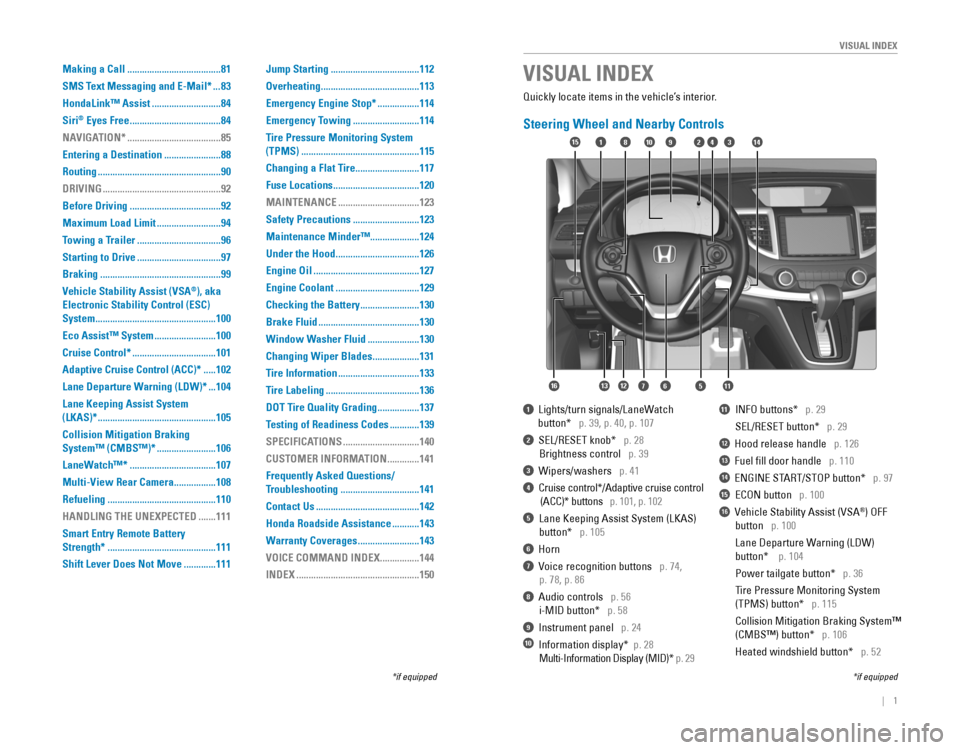
| 1
VISUAL INDEX
Quickly locate items in the vehicle’s interior.
Steering Wheel and Nearby Controls
1‚ÄÇ‚ÄÇLights/turn‚ÄÇsignals/LaneWatch
‚ÄÇ‚ÄÇ‚ÄÇ‚ÄÇ‚ÄÇ‚ÄÇbutton*‚ÄÇ‚ÄÇ‚ÄÇp.‚ÄÇ39,‚ÄÇp.‚ÄÇ40,‚ÄÇp.‚ÄÇ107
2‚ÄÇ‚ÄÇSEL/RESET‚ÄÇknob*‚ÄÇ‚ÄÇ‚ÄÇp. 28
Brightness control p. 39
3‚ÄÇ‚ÄÇWipers/washers‚ÄÇ‚ÄÇ‚ÄÇp.‚ÄÇ41
4‚ÄÇ‚ÄÇCruise‚ÄÇcontrol*/Adaptive‚ÄÇcruise‚ÄÇcontrol‚ÄÇ‚ÄÇ
‚ÄÇ(ACC)*‚ÄÇbuttons‚ÄÇ‚ÄÇ‚ÄÇp. 101, p. 102
5 Lane Keeping Assist System (LKAS)
‚ÄÇbutton* p. 105
6 Horn
7‚ÄÇ‚ÄÇVoice‚ÄÇrecognition‚ÄÇbuttons‚ÄÇ‚ÄÇ‚ÄÇp.‚ÄÇ74,
‚ÄÇp.‚ÄÇ78,‚ÄÇp.‚ÄÇ86
8 Audio controls p. 56
i-MID‚ÄÇbutton*‚ÄÇ‚ÄÇ‚ÄÇp. 58
9‚ÄÇ‚ÄÇInstrument‚ÄÇpanel‚ÄÇ‚ÄÇ‚ÄÇp.‚ÄÇ24
10‚ÄÇ‚ÄÇInformation‚ÄÇdisplay*‚ÄÇ‚ÄÇp. 28
‚ÄÇMulti-Information‚ÄÇDisplay‚ÄÇ(MID)*‚ÄÇp. 29
11‚ÄÇ‚ÄÇ‚ÄÇINFO‚ÄÇbuttons*‚ÄÇ‚ÄÇ‚ÄÇp. 29
SEL/RESET‚ÄÇbutton*‚ÄÇ‚ÄÇ‚ÄÇp. 29
12 Hood release handle p. 126
13 Fuel fill door handle p. 110
14‚ÄÇ‚ÄÇENGINE‚ÄÇSTART/STOP‚ÄÇbutton*‚ÄÇ‚ÄÇ‚ÄÇp.‚ÄÇ97
15 ECON‚ÄÇbutton p. 100
16  Vehicle Stability Assist (VSA®) OFF
‚ÄÇbutton‚ÄÇ‚ÄÇ‚ÄÇp. 100
‚ÄÇLane‚ÄÇDeparture‚ÄÇWarning‚ÄÇ(LDW)‚ÄÇ‚ÄÇ ‚ÄÇ
‚ÄÇbutton*‚ÄÇ‚ÄÇ‚ÄÇ‚ÄÇp.‚ÄÇ104
‚ÄÇPower‚ÄÇtailgate‚ÄÇbutton*‚ÄÇ‚ÄÇ‚ÄÇp. 36
Tire Pressure Monitoring System
‚ÄÇ(TPMS)‚ÄÇbutton*‚ÄÇ‚ÄÇ‚ÄÇp. 115
Collision Mitigation Braking System‚Ñ¢
‚ÄÇ(CMBS‚Ñ¢)‚ÄÇbutton*‚ÄÇ‚ÄÇ‚ÄÇp. 106
‚ÄÇHeated‚ÄÇwindshield‚ÄÇbutton*‚ÄÇ‚ÄÇ‚ÄÇp. 52
VISUAL INDEX
*if‚ÄÇequipped*if‚ÄÇequipped
92
567111213
1815341014
16
Making a Call ......................................81
SMS Text Messaging and E-Mail*
...83
HondaLink‚Ñ¢ Assist
............................84
Siri
® Eyes Free .....................................84
NAVIGATION*
......................................85
Entering a Destination
.......................88
Routing
..................................................90
DRIVING
................................................92
Before Driving
.....................................92
Maximum Load Limit
..........................94
Towing a Trailer
..................................96
Starting to Drive
..................................97
Braking
.................................................99
Vehicle Stability Assist (VSA
®), aka
Electronic Stability Control (ESC)
System
.................................................100
Eco Assist‚Ñ¢ System
.........................100
Cruise Control*
..................................101
Adaptive Cruise Control (ACC)*
.....102
Lane Departure Warning (LDW)*
...104
Lane Keeping Assist System
(LKAS)*
................................................105
Collision Mitigation Braking
System‚Ñ¢ (CMBS‚Ñ¢)*
........................106
LaneWatch‚Ñ¢*
...................................107
Multi-View Rear Camera
.................108
Refueling
............................................110
HANDLING THE UNEXPECTED
.......111
Smart Entry Remote Battery
Strength*
............................................111
Shift Lever Does Not Move
.............111 Jump Starting
....................................112
Overheating
........................................113
Emergency Engine Stop*
.................114
Emergency Towing
...........................114
Tire Pressure Monitoring System
(TPMS)
................................................115
Changing a Flat Tire
..........................117
Fuse Locations
...................................120
MAINTENANCE
.................................123
Safety Precautions
...........................123
Maintenance Minder‚Ñ¢ ....................124
Under the Hood
..................................126
Engine Oil
...........................................127
Engine Coolant
..................................129
Checking the Battery
........................130
Brake Fluid
.........................................130
Window Washer Fluid
.....................130
Changing Wiper Blades
...................131
Tire Information
.................................133
Tire Labeling
......................................136
DOT Tire Quality Grading
.................137
Testing of Readiness Codes
............139
SPECIFICATIONS
...............................140
CUSTOMER INFORMATION
.............141
Frequently Asked Questions/
Troubleshooting
................................141
Contact Us
..........................................142
Honda Roadside Assistance
...........143
Warranty Coverages
.........................143
VOICE COMMAND INDEX
................144
INDEX
..................................................150
Page 16 of 80
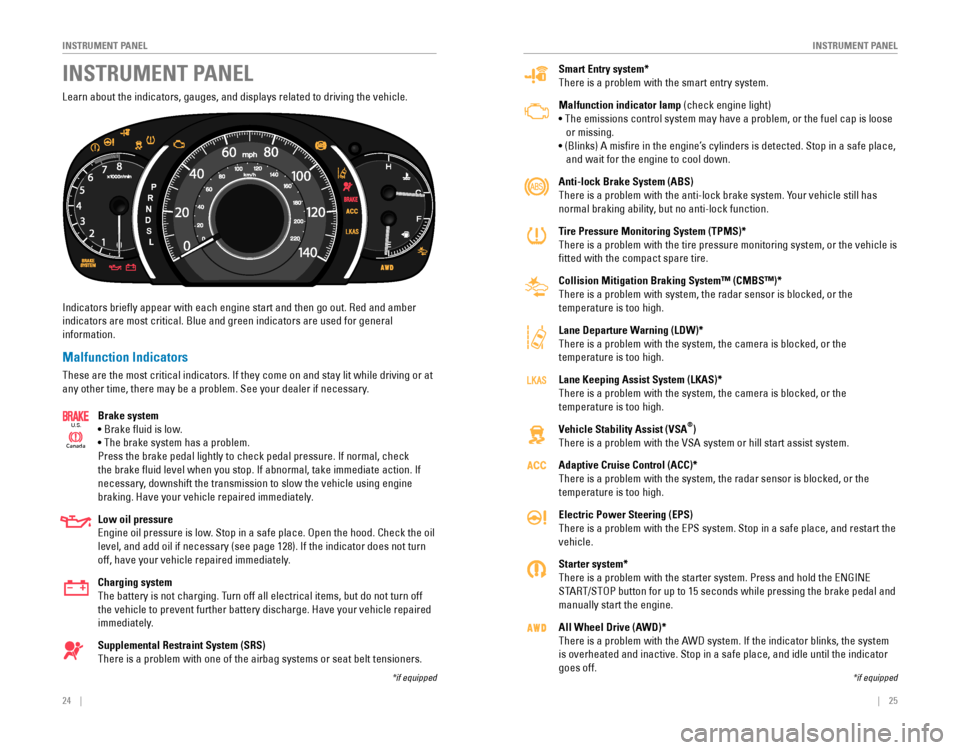
24‚ÄÇ‚ÄÇ‚ÄÇ‚ÄÇ|| 25
I
NSTRUMENT PANELINSTRUMENT PANEL
Smart Entry system*
There‚ÄÇis‚ÄÇa‚ÄÇproblem‚ÄÇwith‚ÄÇthe‚ÄÇsmart‚ÄÇentry‚ÄÇsystem.
Malfunction indicator lamp (check engine light)
• The emissions control system may have a problem, or the fuel cap is loose  
or missing.
• (Blinks) A misfire in the engine’s cylinders is detected. Stop in a safe place, 
and wait for the engine to cool down.
Anti-lock Brake System (ABS)
There‚ÄÇis‚ÄÇa‚ÄÇproblem‚ÄÇwith‚ÄÇthe‚ÄÇanti-lock‚ÄÇbrake‚ÄÇsystem.‚ÄÇYour‚ÄÇvehicle‚ÄÇstill‚ÄÇhas‚ÄÇ
normal‚ÄÇbraking‚ÄÇability,‚ÄÇbut‚ÄÇno‚ÄÇanti-lock‚ÄÇfunction.‚ÄÇ
Tire Pressure Monitoring System (TPMS)*
There‚ÄÇis‚ÄÇa‚ÄÇproblem‚ÄÇwith‚ÄÇthe‚ÄÇtire‚ÄÇpressure‚ÄÇmonitoring‚ÄÇsystem,‚ÄÇor‚ÄÇthe‚ÄÇvehicle‚ÄÇis‚ÄÇ
fitted with the compact spare tire.
Collision Mitigation Braking System‚Ñ¢ (CMBS‚Ñ¢)*
There‚ÄÇis‚ÄÇa‚ÄÇproblem‚ÄÇwith‚ÄÇsystem,‚ÄÇthe‚ÄÇradar‚ÄÇsensor‚ÄÇis‚ÄÇblocked,‚ÄÇor‚ÄÇthe‚ÄÇ
temperature is too high.
Lane Departure Warning (LDW)*
There‚ÄÇis‚ÄÇa‚ÄÇproblem‚ÄÇwith‚ÄÇthe‚ÄÇsystem,‚ÄÇthe‚ÄÇcamera‚ÄÇis‚ÄÇblocked,‚ÄÇor‚ÄÇthe‚ÄÇ
temperature is too high.
Lane Keeping Assist System (LKAS)*
There‚ÄÇis‚ÄÇa‚ÄÇproblem‚ÄÇwith‚ÄÇthe‚ÄÇsystem,‚ÄÇthe‚ÄÇcamera‚ÄÇis‚ÄÇblocked,‚ÄÇor‚ÄÇthe‚ÄÇ
temperature is too high.
Vehicle Stability Assist (VSA
®)
There‚ÄÇis‚ÄÇa‚ÄÇproblem‚ÄÇwith‚ÄÇthe‚ÄÇVSA‚ÄÇsystem‚ÄÇor‚ÄÇhill‚ÄÇstart‚ÄÇassist‚ÄÇsystem.
Adaptive Cruise Control (ACC)*
There‚ÄÇis‚ÄÇa‚ÄÇproblem‚ÄÇwith‚ÄÇthe‚ÄÇsystem,‚ÄÇthe‚ÄÇradar‚ÄÇsensor‚ÄÇis‚ÄÇblocked,‚ÄÇor‚ÄÇthe‚ÄÇ
temperature is too high.
Electric Power Steering (EPS)
There‚ÄÇis‚ÄÇa‚ÄÇproblem‚ÄÇwith‚ÄÇthe‚ÄÇEPS‚ÄÇsystem.‚ÄÇStop‚ÄÇin‚ÄÇa‚ÄÇsafe‚ÄÇplace,‚ÄÇand‚ÄÇrestart‚ÄÇthe‚ÄÇ
vehicle.
Starter system*
There‚ÄÇis‚ÄÇa‚ÄÇproblem‚ÄÇwith‚ÄÇthe‚ÄÇstarter‚ÄÇsystem.‚ÄÇPress‚ÄÇand‚ÄÇhold‚ÄÇthe‚ÄÇENGINE‚ÄÇ
START/STOP‚ÄÇbutton‚ÄÇfor‚ÄÇup‚ÄÇto‚ÄÇ15‚ÄÇseconds‚ÄÇwhile‚ÄÇpressing‚ÄÇthe‚ÄÇbrake‚ÄÇpedal‚ÄÇand‚ÄÇ
manually start the engine.
All Wheel Drive (AWD)*
There‚ÄÇis‚ÄÇa‚ÄÇproblem‚ÄÇwith‚ÄÇthe‚ÄÇAWD‚ÄÇsystem.‚ÄÇIf‚ÄÇthe‚ÄÇindicator‚ÄÇblinks,‚ÄÇthe‚ÄÇsystem‚ÄÇ
is overheated and inactive. Stop in a safe place, and idle until the ind\
icator
goes off.
Learn‚ÄÇabout‚ÄÇthe‚ÄÇindicators,‚ÄÇgauges,‚ÄÇand‚ÄÇdisplays‚ÄÇrelated‚ÄÇto‚ÄÇdriving‚ÄÇthe‚ÄÇvehicle.
Indicators‚ÄÇbriefly‚ÄÇappear‚ÄÇwith‚ÄÇeach‚ÄÇengine‚ÄÇstart‚ÄÇand‚ÄÇthen‚ÄÇgo‚ÄÇout.‚ÄÇRed‚ÄÇand‚ÄÇamber‚ÄÇ
indicators are most critical. Blue and green indicators are used for general?
information.
Malfunction Indicators
These‚ÄÇare‚ÄÇthe‚ÄÇmost‚ÄÇcritical‚ÄÇindicators.‚ÄÇIf‚ÄÇthey‚ÄÇcome‚ÄÇon‚ÄÇand‚ÄÇstay‚ÄÇlit‚ÄÇwhile‚ÄÇdriving‚ÄÇor‚ÄÇat‚ÄÇ
any‚ÄÇother‚ÄÇtime,‚ÄÇthere‚ÄÇmay‚ÄÇbe‚ÄÇa‚ÄÇproblem.‚ÄÇSee‚ÄÇyour‚ÄÇdealer‚ÄÇif‚ÄÇnecessary.
Brake system
• Brake fluid is low.
• The brake system has a problem.
Press‚ÄÇthe‚ÄÇbrake‚ÄÇpedal‚ÄÇlightly‚ÄÇto‚ÄÇcheck‚ÄÇpedal‚ÄÇpressure.‚ÄÇIf‚ÄÇnormal,‚ÄÇcheck‚ÄÇ
the‚ÄÇbrake‚ÄÇfluid‚ÄÇlevel‚ÄÇwhen‚ÄÇyou‚ÄÇstop.‚ÄÇIf‚ÄÇabnormal,‚ÄÇtake‚ÄÇimmediate‚ÄÇaction.‚ÄÇIf‚ÄÇ
necessary, downshift the transmission to slow the vehicle using engine
braking.‚ÄÇHave‚ÄÇyour‚ÄÇvehicle‚ÄÇrepaired‚ÄÇimmediately.
Low oil pressure
Engine‚ÄÇoil‚ÄÇpressure‚ÄÇis‚ÄÇlow.‚ÄÇStop‚ÄÇin‚ÄÇa‚ÄÇsafe‚ÄÇplace.‚ÄÇOpen‚ÄÇthe‚ÄÇhood.‚ÄÇCheck‚ÄÇthe‚ÄÇoil‚ÄÇ
level,‚ÄÇand‚ÄÇadd‚ÄÇoil‚ÄÇif‚ÄÇnecessary‚ÄÇ(see‚ÄÇpage‚ÄÇ128).‚ÄÇIf‚ÄÇthe‚ÄÇindicator‚ÄÇdoes‚ÄÇnot‚ÄÇturn‚ÄÇ
off, have your vehicle repaired immediately.
Charging system
The‚ÄÇbattery‚ÄÇis‚ÄÇnot‚ÄÇcharging.‚ÄÇTurn‚ÄÇoff‚ÄÇall‚ÄÇelectrical‚ÄÇitems,‚ÄÇbut‚ÄÇdo‚ÄÇnot‚ÄÇturn‚ÄÇoff‚ÄÇ
the‚ÄÇvehicle‚ÄÇto‚ÄÇprevent‚ÄÇfurther‚ÄÇbattery‚ÄÇdischarge.‚ÄÇHave‚ÄÇyour‚ÄÇvehicle‚ÄÇrepaired‚ÄÇ
immediately.
Supplemental Restraint System (SRS)
There‚ÄÇis‚ÄÇa‚ÄÇproblem‚ÄÇwith‚ÄÇone‚ÄÇof‚ÄÇthe‚ÄÇairbag‚ÄÇsystems‚ÄÇor‚ÄÇseat‚ÄÇbelt‚ÄÇtensioners.‚ÄÇ
Ca nada
U.S.
INSTRUMENT PANEL
*if‚ÄÇequipped*if‚ÄÇequipped
Page 52 of 80
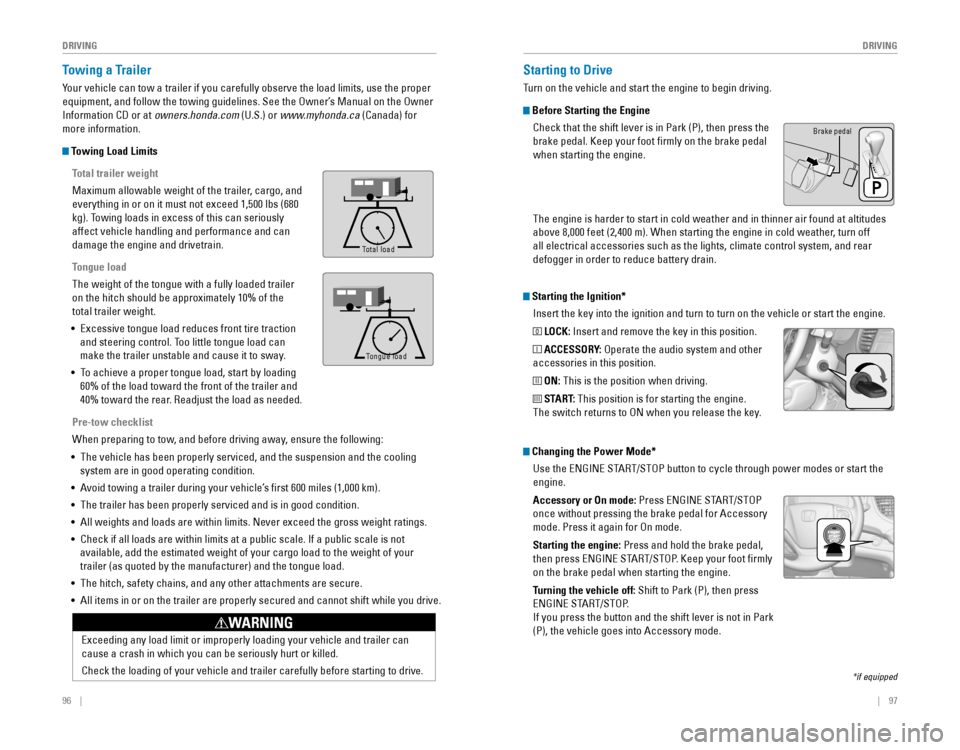
96 ||‚ÄÇ‚ÄÇ‚ÄÇ‚ÄÇ97
DRIVING
DRIVING
Exceeding‚ÄÇany‚ÄÇload‚ÄÇlimit‚ÄÇor‚ÄÇimproperly‚ÄÇloading‚ÄÇyour‚ÄÇvehicle‚ÄÇand‚ÄÇtrailer‚ÄÇcan‚ÄÇ
cause‚ÄÇa‚ÄÇcrash‚ÄÇin‚ÄÇwhich‚ÄÇyou‚ÄÇcan‚ÄÇbe‚ÄÇseriously‚ÄÇhurt‚ÄÇor‚ÄÇkilled.
Check‚ÄÇthe‚ÄÇloading‚ÄÇof‚ÄÇyour‚ÄÇvehicle‚ÄÇand‚ÄÇtrailer‚ÄÇcarefully‚ÄÇbefore‚ÄÇstarting‚ÄÇto‚ÄÇdrive.
WARNING
Towing a Trailer
Your‚ÄÇvehicle‚ÄÇcan‚ÄÇtow‚ÄÇa‚ÄÇtrailer‚ÄÇif‚ÄÇyou‚ÄÇcarefully‚ÄÇobserve‚ÄÇthe‚ÄÇload‚ÄÇlimits,‚ÄÇuse‚ÄÇthe‚ÄÇproper‚ÄÇ
equipment, and follow the towing guidelines. See the Owner’s Manual on the Owner 
Information‚ÄÇCD‚ÄÇor‚ÄÇat‚ÄÇowners.honda.com (U.S.) or www.myhonda.ca (Canada) for
more information.
Towing Load Limits
Total trailer weight
Maximum‚ÄÇallowable‚ÄÇweight‚ÄÇof‚ÄÇthe‚ÄÇtrailer,‚ÄÇcargo,‚ÄÇand‚ÄÇ
everything‚ÄÇin‚ÄÇor‚ÄÇon‚ÄÇit‚ÄÇmust‚ÄÇnot‚ÄÇexceed‚ÄÇ1,500‚ÄÇlbs‚ÄÇ(680‚ÄÇ
kg). Towing loads in excess of this can seriously
affect vehicle handling and performance and can
damage the engine and drivetrain.
Tongue load
The weight of the tongue with a fully loaded trailer
on‚ÄÇthe‚ÄÇhitch‚ÄÇshould‚ÄÇbe‚ÄÇapproximately‚ÄÇ10%‚ÄÇof‚ÄÇthe‚ÄÇ
total trailer weight.
• 
Excessive‚ÄÇtongue‚ÄÇload‚ÄÇreduces‚ÄÇfront‚ÄÇtire‚ÄÇtraction‚ÄÇ
and steering control. Too little tongue load can
make‚ÄÇthe‚ÄÇtrailer‚ÄÇunstable‚ÄÇand‚ÄÇcause‚ÄÇit‚ÄÇto‚ÄÇsway.
• To achieve a proper tongue load, start by loading 
60%‚ÄÇof‚ÄÇthe‚ÄÇload‚ÄÇtoward‚ÄÇthe‚ÄÇfront‚ÄÇof‚ÄÇthe‚ÄÇtrailer‚ÄÇand‚ÄÇ
40%‚ÄÇtoward‚ÄÇthe‚ÄÇrear.‚ÄÇReadjust‚ÄÇthe‚ÄÇload‚ÄÇas‚ÄÇneeded.
Pre-tow checklist
When‚ÄÇpreparing‚ÄÇto‚ÄÇtow,‚ÄÇand‚ÄÇbefore‚ÄÇdriving‚ÄÇaway,‚ÄÇensure‚ÄÇthe‚ÄÇfollowing:
• The vehicle has been properly serviced, and the suspension and the cooling 
system are in good operating condition.
•  Avoid towing a trailer during your vehicle’s first 600 miles (1,000 km).
• 
The‚ÄÇtrailer‚ÄÇhas‚ÄÇbeen‚ÄÇproperly‚ÄÇserviced‚ÄÇand‚ÄÇis‚ÄÇin‚ÄÇgood‚ÄÇcondition.
•  All weights and loads are within limits. Never exceed the gross weight r\
atings.
• 
Check‚ÄÇif‚ÄÇall‚ÄÇloads‚ÄÇare‚ÄÇwithin‚ÄÇlimits‚ÄÇat‚ÄÇa‚ÄÇpublic‚ÄÇscale.‚ÄÇIf‚ÄÇa‚ÄÇpublic‚ÄÇscale‚ÄÇis‚ÄÇnot‚ÄÇ
available,‚ÄÇadd‚ÄÇthe‚ÄÇestimated‚ÄÇweight‚ÄÇof‚ÄÇyour‚ÄÇcargo‚ÄÇload‚ÄÇto‚ÄÇthe‚ÄÇweight‚ÄÇof‚ÄÇyour‚ÄÇ
trailer‚ÄÇ(as‚ÄÇquoted‚ÄÇby‚ÄÇthe‚ÄÇmanufacturer)‚ÄÇand‚ÄÇthe‚ÄÇtongue‚ÄÇload.
•  The hitch, safety chains, and any other attachments are secure.
•  All items in or on the trailer are properly secured and cannot shift whi\
le you drive.
To ng ue Loa d
Tong ue Loa d
Total load
Tongue load
Starting the Ignition*
Insert‚ÄÇthe‚ÄÇkey‚ÄÇinto‚ÄÇthe‚ÄÇignition‚ÄÇand‚ÄÇturn‚ÄÇto‚ÄÇturn‚ÄÇon‚ÄÇthe‚ÄÇvehicle‚ÄÇor‚ÄÇstart‚ÄÇthe‚ÄÇengine.
0 LOCK: Insert‚ÄÇand‚ÄÇremove‚ÄÇthe‚ÄÇkey‚ÄÇin‚ÄÇthis‚ÄÇposition.
I ACCESSORY: Operate the audio system and other
accessories in this position.
II ON: This is the position when driving.
III START: This position is for starting the engine.
The switch returns to ON when you release the key.
Starting to Drive
Turn‚ÄÇon‚ÄÇthe‚ÄÇvehicle‚ÄÇand‚ÄÇstart‚ÄÇthe‚ÄÇengine‚ÄÇto‚ÄÇbegin‚ÄÇdriving.
Before Starting the Engine
Check that the shift lever is in Park (P), then press the
brake‚ÄÇpedal.‚ÄÇKeep‚ÄÇyour‚ÄÇfoot‚ÄÇfirmly‚ÄÇon‚ÄÇthe‚ÄÇbrake‚ÄÇpedal‚ÄÇ
when starting the engine.
Brake pedal
The engine is harder to start in cold weather and in thinner air found a\
t altitudes
above‚ÄÇ8,000‚ÄÇfeet‚ÄÇ(2,400‚ÄÇm).‚ÄÇWhen‚ÄÇstarting‚ÄÇthe‚ÄÇengine‚ÄÇin‚ÄÇcold‚ÄÇweather,‚ÄÇturn‚ÄÇoff‚ÄÇ
all electrical accessories such as the lights, climate control system, a\
nd rear
defogger‚ÄÇin‚ÄÇorder‚ÄÇto‚ÄÇreduce‚ÄÇbattery‚ÄÇdrain.
*if‚ÄÇequipped
Changing the Power Mode*Use the
ENGINE‚ÄÇSTART/STOP‚ÄÇbutton‚ÄÇto‚ÄÇcycle‚ÄÇthrough‚ÄÇpower‚ÄÇmodes‚ÄÇor‚ÄÇstart‚ÄÇthe‚ÄÇ
engine.
Accessory or On mode:
Press‚ÄÇENGINE‚ÄÇSTART/STOP‚ÄÇ
once‚ÄÇwithout‚ÄÇpressing‚ÄÇthe‚ÄÇbrake‚ÄÇpedal‚ÄÇfor‚ÄÇAccessory‚ÄÇ
mode. Press it again for On mode.
Starting the engine:
Press‚ÄÇand‚ÄÇhold‚ÄÇthe‚ÄÇbrake‚ÄÇpedal,‚ÄÇ
then‚ÄÇpress‚ÄÇENGINE‚ÄÇSTART/STOP.‚ÄÇKeep‚ÄÇyour‚ÄÇfoot‚ÄÇfirmly‚ÄÇ
on‚ÄÇthe‚ÄÇbrake‚ÄÇpedal‚ÄÇwhen‚ÄÇstarting‚ÄÇthe‚ÄÇengine.
Turning the vehicle off: Shift to Park (P), then press
ENGINE‚ÄÇSTART/STOP.
If‚ÄÇyou‚ÄÇpress‚ÄÇthe‚ÄÇbutton‚ÄÇand‚ÄÇthe‚ÄÇshift‚ÄÇlever‚ÄÇis‚ÄÇnot‚ÄÇin‚ÄÇPark‚ÄÇ
(P), the vehicle goes into Accessory mode.
Page 59 of 80
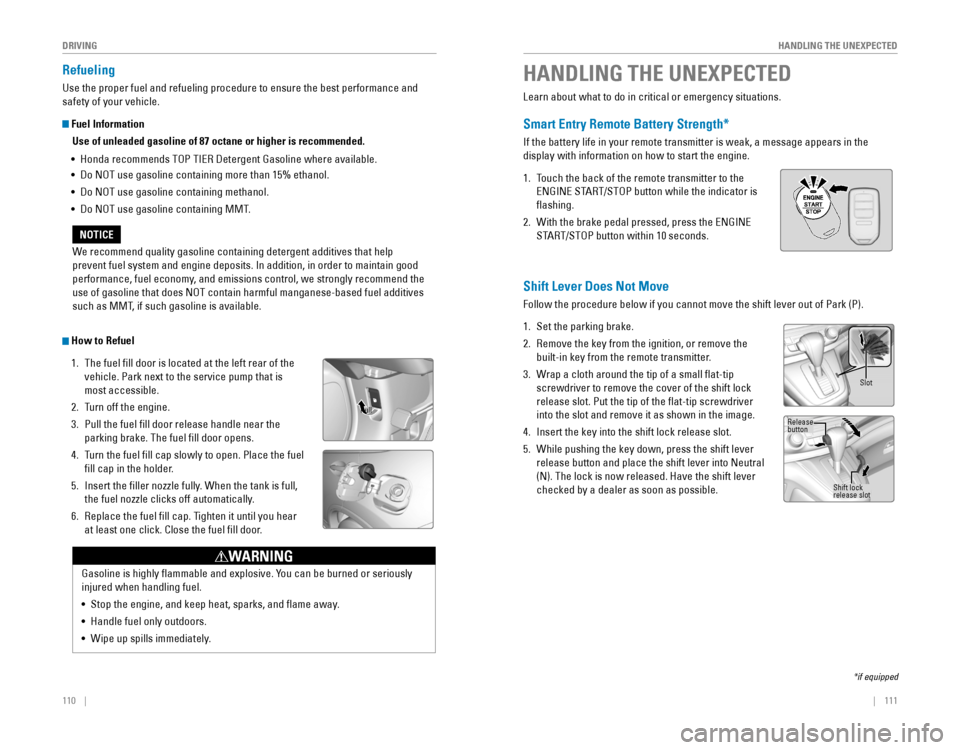
110 || 111
HANDLING THE UNEXPECTED
DRIVING
Refueling
Use‚ÄÇthe‚ÄÇproper‚ÄÇfuel‚ÄÇand‚ÄÇrefueling‚ÄÇprocedure‚ÄÇto‚ÄÇensure‚ÄÇthe‚ÄÇbest‚ÄÇperformance‚ÄÇand‚ÄÇ
safety of your vehicle.
Fuel Information
Use of unleaded gasoline of 87 octane or higher is recommended.
• 
Honda‚ÄÇrecommends‚ÄÇTOP‚ÄÇTIER‚ÄÇDetergent‚ÄÇGasoline‚ÄÇwhere‚ÄÇavailable.
• Do NOT use gasoline containing more than 15% ethanol.
• Do NOT use gasoline containing methanol.
• Do NOT use gasoline containing MMT.
Learn‚ÄÇabout‚ÄÇwhat‚ÄÇto‚ÄÇdo‚ÄÇin‚ÄÇcritical‚ÄÇor‚ÄÇemergency‚ÄÇsituations.
Smart Entry Remote Battery Strength*
If‚ÄÇthe‚ÄÇbattery‚ÄÇlife‚ÄÇin‚ÄÇyour‚ÄÇremote‚ÄÇtransmitter‚ÄÇis‚ÄÇweak,‚ÄÇa‚ÄÇmessage‚ÄÇappears‚ÄÇin‚ÄÇthe‚ÄÇ
display with information on how to start the engine.
1. Touch‚ÄÇthe‚ÄÇback‚ÄÇof‚ÄÇthe‚ÄÇremote‚ÄÇtransmitter‚ÄÇto‚ÄÇthe‚ÄÇ
ENGINE‚ÄÇSTART/STOP‚ÄÇbutton‚ÄÇwhile‚ÄÇthe‚ÄÇindicator‚ÄÇis‚ÄÇ
flashing.
2. With‚ÄÇthe‚ÄÇbrake‚ÄÇpedal‚ÄÇpressed,‚ÄÇpress‚ÄÇthe‚ÄÇENGINE‚ÄÇ
START/STOP‚ÄÇbutton‚ÄÇwithin‚ÄÇ10‚ÄÇseconds.
HANDLING THE UNEXPECTED
*if‚ÄÇequipped
We‚ÄÇrecommend‚ÄÇquality‚ÄÇgasoline‚ÄÇcontaining‚ÄÇdetergent‚ÄÇadditives‚ÄÇthat‚ÄÇhelp‚ÄÇ
prevent‚ÄÇfuel‚ÄÇsystem‚ÄÇand‚ÄÇengine‚ÄÇdeposits.‚ÄÇIn‚ÄÇaddition,‚ÄÇin‚ÄÇorder‚ÄÇto‚ÄÇmaintain‚ÄÇgood‚ÄÇ
performance, fuel economy, and emissions control, we strongly recommend the
use‚ÄÇof‚ÄÇgasoline‚ÄÇthat‚ÄÇdoes‚ÄÇNOT‚ÄÇcontain‚ÄÇharmful‚ÄÇmanganese-based‚ÄÇfuel‚ÄÇadditives‚ÄÇ
such‚ÄÇas‚ÄÇMMT,‚ÄÇif‚ÄÇsuch‚ÄÇgasoline‚ÄÇis‚ÄÇavailable.‚ÄÇ
NOTICE
Gasoline‚ÄÇis‚ÄÇhighly‚ÄÇflammable‚ÄÇand‚ÄÇexplosive.‚ÄÇYou‚ÄÇcan‚ÄÇbe‚ÄÇburned‚ÄÇor‚ÄÇseriously‚ÄÇ
injured when handling fuel.
•  Stop the engine, and keep heat, sparks, and flame away.
•  Handle fuel only outdoors.
•  Wipe up spills immediately.
WARNING
How to Refuel
1. The fuel fill door is located at the left rear of the
vehicle. Park next to the service pump that is
most‚ÄÇaccessible.
2. Turn off the engine.
3. Pull the fuel fill door release handle near the
parking‚ÄÇbrake.‚ÄÇThe‚ÄÇfuel‚ÄÇfill‚ÄÇdoor‚ÄÇopens.
4.‚ÄÇTurn the fuel fill cap slowly to open. Place the fuel
fill cap in the holder.
5. Insert‚ÄÇthe‚ÄÇfiller‚ÄÇnozzle‚ÄÇfully.‚ÄÇWhen‚ÄÇthe‚ÄÇtank‚ÄÇis‚ÄÇfull,‚ÄÇ
the‚ÄÇfuel‚ÄÇnozzle‚ÄÇclicks‚ÄÇoff‚ÄÇautomatically.
6. Replace the fuel fill cap. Tighten it until you hear
at least one click. Close the fuel fill door.
Pull
Shift Lever Does Not Move
Follow‚ÄÇthe‚ÄÇprocedure‚ÄÇbelow‚ÄÇif‚ÄÇyou‚ÄÇcannot‚ÄÇmove‚ÄÇthe‚ÄÇshift‚ÄÇlever‚ÄÇout‚ÄÇof‚ÄÇPark‚ÄÇ(P).
1. Set‚ÄÇthe‚ÄÇparking‚ÄÇbrake.
2. Remove the key from the ignition, or remove the
built-in‚ÄÇkey‚ÄÇfrom‚ÄÇthe‚ÄÇremote‚ÄÇtransmitter.
3. Wrap a cloth around the tip of a small flat-tip
screwdriver to remove the cover of the shift lock
release slot. Put the tip of the flat-tip screwdriver
into the slot and remove it as shown in the image.
4.‚ÄÇInsert‚ÄÇthe‚ÄÇkey‚ÄÇinto‚ÄÇthe‚ÄÇshift‚ÄÇlock‚ÄÇrelease‚ÄÇslot.
5. While pushing the key down, press the shift lever
release‚ÄÇbutton‚ÄÇand‚ÄÇplace‚ÄÇthe‚ÄÇshift‚ÄÇlever‚ÄÇinto‚ÄÇNeutral‚ÄÇ‚ÄÇ
(N). The lock is now released. Have the shift lever
checked‚ÄÇby‚ÄÇa‚ÄÇdealer‚ÄÇas‚ÄÇsoon‚ÄÇas‚ÄÇpossible.
Slot
Release
button
Shift lock
release slot
Page 60 of 80
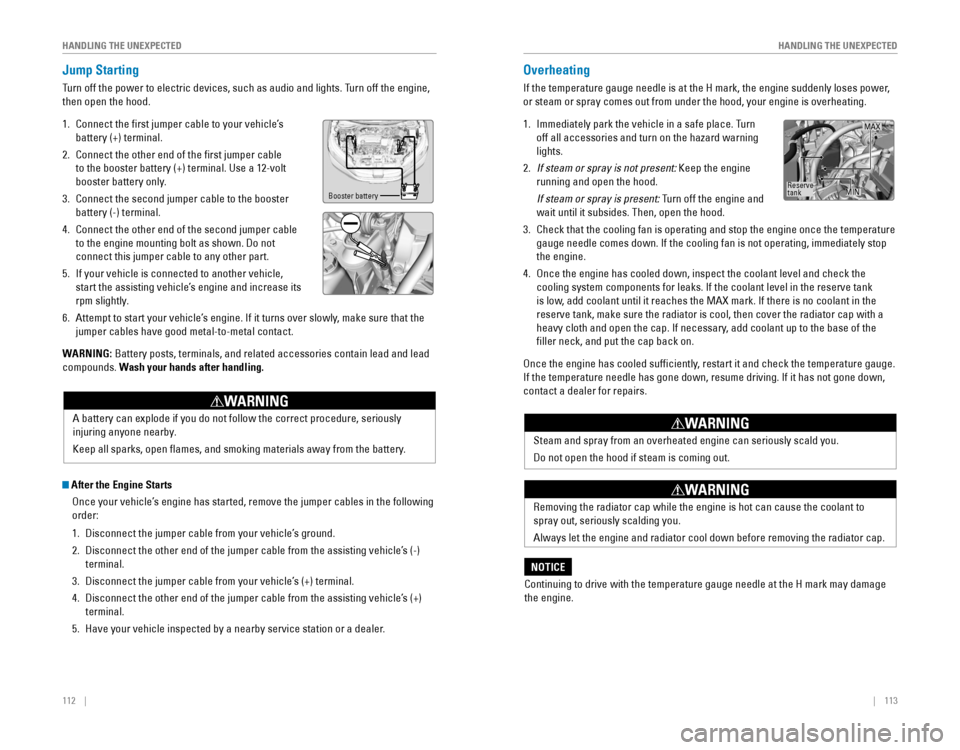
112 || 113
HANDLING THE UNEXPECTED
HANDLING THE UNEXPECTED
After the Engine Starts
Once your vehicle’s engine has started, remove the jumper cables in the following 
order:
1. Disconnect the jumper cable from your vehicle’s ground.
2. Disconnect the other end of the jumper cable from the assisting vehicle’s (-) 
terminal.
3. Disconnect the jumper cable from your vehicle’s (+) terminal.
4. Disconnect the other end of the jumper cable from the assisting vehicle’s (+) 
terminal.
5. Have‚ÄÇyour‚ÄÇvehicle‚ÄÇinspected‚ÄÇby‚ÄÇa‚ÄÇnearby‚ÄÇservice‚ÄÇstation‚ÄÇor‚ÄÇa‚ÄÇdealer.
Overheating
If‚ÄÇthe‚ÄÇtemperature‚ÄÇgauge‚ÄÇneedle‚ÄÇis‚ÄÇat‚ÄÇthe‚ÄÇH‚ÄÇmark,‚ÄÇthe‚ÄÇengine‚ÄÇsuddenly‚ÄÇloses‚ÄÇpower,‚ÄÇ
or steam or spray comes out from under the hood, your engine is overheat\
ing.
1. Immediately‚ÄÇpark‚ÄÇthe‚ÄÇvehicle‚ÄÇin‚ÄÇa‚ÄÇsafe‚ÄÇplace.‚ÄÇTurn‚ÄÇ
off‚ÄÇall‚ÄÇaccessories‚ÄÇand‚ÄÇturn‚ÄÇon‚ÄÇthe‚ÄÇhazard‚ÄÇwarning‚ÄÇ
lights.
2. If‚ÄÇsteam‚ÄÇor‚ÄÇspray‚ÄÇis‚ÄÇnot‚ÄÇpresent: Keep the engine
running and open the hood.
‚ÄÇIf‚ÄÇsteam‚ÄÇor‚ÄÇspray‚ÄÇis‚ÄÇpresent: Turn off the engine and
wait‚ÄÇuntil‚ÄÇit‚ÄÇsubsides.‚ÄÇThen,‚ÄÇopen‚ÄÇthe‚ÄÇhood.
3. Check that the cooling fan is operating and stop the engine once the tem\
perature
gauge‚ÄÇneedle‚ÄÇcomes‚ÄÇdown.‚ÄÇIf‚ÄÇthe‚ÄÇcooling‚ÄÇfan‚ÄÇis‚ÄÇnot‚ÄÇoperating,‚ÄÇimmediately‚ÄÇstop‚ÄÇ
the engine.
4.‚ÄÇOnce‚ÄÇthe‚ÄÇengine‚ÄÇhas‚ÄÇcooled‚ÄÇdown,‚ÄÇinspect‚ÄÇthe‚ÄÇcoolant‚ÄÇlevel‚ÄÇand‚ÄÇcheck‚ÄÇthe‚ÄÇ
cooling‚ÄÇsystem‚ÄÇcomponents‚ÄÇfor‚ÄÇleaks.‚ÄÇIf‚ÄÇthe‚ÄÇcoolant‚ÄÇlevel‚ÄÇin‚ÄÇthe‚ÄÇreserve‚ÄÇtank‚ÄÇ
is‚ÄÇlow,‚ÄÇadd‚ÄÇcoolant‚ÄÇuntil‚ÄÇit‚ÄÇreaches‚ÄÇthe‚ÄÇMAX‚ÄÇmark.‚ÄÇIf‚ÄÇthere‚ÄÇis‚ÄÇno‚ÄÇcoolant‚ÄÇin‚ÄÇthe‚ÄÇ
reserve tank, make sure the radiator is cool, then cover the radiator ca\
p with a
heavy‚ÄÇcloth‚ÄÇand‚ÄÇopen‚ÄÇthe‚ÄÇcap.‚ÄÇIf‚ÄÇnecessary,‚ÄÇadd‚ÄÇcoolant‚ÄÇup‚ÄÇto‚ÄÇthe‚ÄÇbase‚ÄÇof‚ÄÇthe‚ÄÇ
filler‚ÄÇneck,‚ÄÇand‚ÄÇput‚ÄÇthe‚ÄÇcap‚ÄÇback‚ÄÇon.
Once the engine has cooled sufficiently, restart it and check the temperature gauge.
If‚ÄÇthe‚ÄÇtemperature‚ÄÇneedle‚ÄÇhas‚ÄÇgone‚ÄÇdown,‚ÄÇresume‚ÄÇdriving.‚ÄÇIf‚ÄÇit‚ÄÇhas‚ÄÇnot‚ÄÇgone‚ÄÇdown,‚ÄÇ
contact a dealer for repairs.
Reserve
tank MAX
MIN
A‚ÄÇbattery‚ÄÇcan‚ÄÇexplode‚ÄÇif‚ÄÇyou‚ÄÇdo‚ÄÇnot‚ÄÇfollow‚ÄÇthe‚ÄÇcorrect‚ÄÇprocedure,‚ÄÇseriously‚ÄÇ
injuring‚ÄÇanyone‚ÄÇnearby.
Keep‚ÄÇall‚ÄÇsparks,‚ÄÇopen‚ÄÇflames,‚ÄÇand‚ÄÇsmoking‚ÄÇmaterials‚ÄÇaway‚ÄÇfrom‚ÄÇthe‚ÄÇbattery.
WARNING
Jump Starting
Turn off the power to electric devices, such as audio and lights. Turn off the engine,
then open the hood.
1. Connect the first jumper cable to your vehicle’s 
battery‚ÄÇ(+)‚ÄÇterminal.
2. Connect‚ÄÇthe‚ÄÇother‚ÄÇend‚ÄÇof‚ÄÇthe‚ÄÇfirst‚ÄÇjumper‚ÄÇcable‚ÄÇ
to‚ÄÇthe‚ÄÇbooster‚ÄÇbattery‚ÄÇ(+)‚ÄÇterminal.‚ÄÇUse‚ÄÇa‚ÄÇ12-volt‚ÄÇ
booster‚ÄÇbattery‚ÄÇonly.
3. Connect‚ÄÇthe‚ÄÇsecond‚ÄÇjumper‚ÄÇcable‚ÄÇto‚ÄÇthe‚ÄÇbooster‚ÄÇ
battery‚ÄÇ(-)‚ÄÇterminal.
4.‚ÄÇConnect‚ÄÇthe‚ÄÇother‚ÄÇend‚ÄÇof‚ÄÇthe‚ÄÇsecond‚ÄÇjumper‚ÄÇcable‚ÄÇ
to‚ÄÇthe‚ÄÇengine‚ÄÇmounting‚ÄÇbolt‚ÄÇas‚ÄÇshown.‚ÄÇDo‚ÄÇnot‚ÄÇ
connect‚ÄÇthis‚ÄÇjumper‚ÄÇcable‚ÄÇto‚ÄÇany‚ÄÇother‚ÄÇpart.
5. If‚ÄÇyour‚ÄÇvehicle‚ÄÇis‚ÄÇconnected‚ÄÇto‚ÄÇanother‚ÄÇvehicle,‚ÄÇ
start the assisting vehicle’s engine and increase its
rpm slightly.
6. Attempt to start your vehicle’s engine. If it turns over slowly, make sure that the 
jumper‚ÄÇcables‚ÄÇhave‚ÄÇgood‚ÄÇmetal-to-metal‚ÄÇcontact.
WARNING: Battery posts, terminals, and related accessories contain lead and lead\
compounds. Wash your hands after handling.
Booster‚ÄÇbattery
Steam and spray from an overheated engine can seriously scald you.
Do‚ÄÇnot‚ÄÇopen‚ÄÇthe‚ÄÇhood‚ÄÇif‚ÄÇsteam‚ÄÇis‚ÄÇcoming‚ÄÇout.
WARNING
Removing the radiator cap while the engine is hot can cause the coolant \
to
spray out, seriously scalding you.
Always‚ÄÇlet‚ÄÇthe‚ÄÇengine‚ÄÇand‚ÄÇradiator‚ÄÇcool‚ÄÇdown‚ÄÇbefore‚ÄÇremoving‚ÄÇthe‚ÄÇradiator‚ÄÇcap.
WARNING
Continuing to drive with the temperature gauge needle at the H mark may \
damage
the engine.
NOTICE
Page 65 of 80
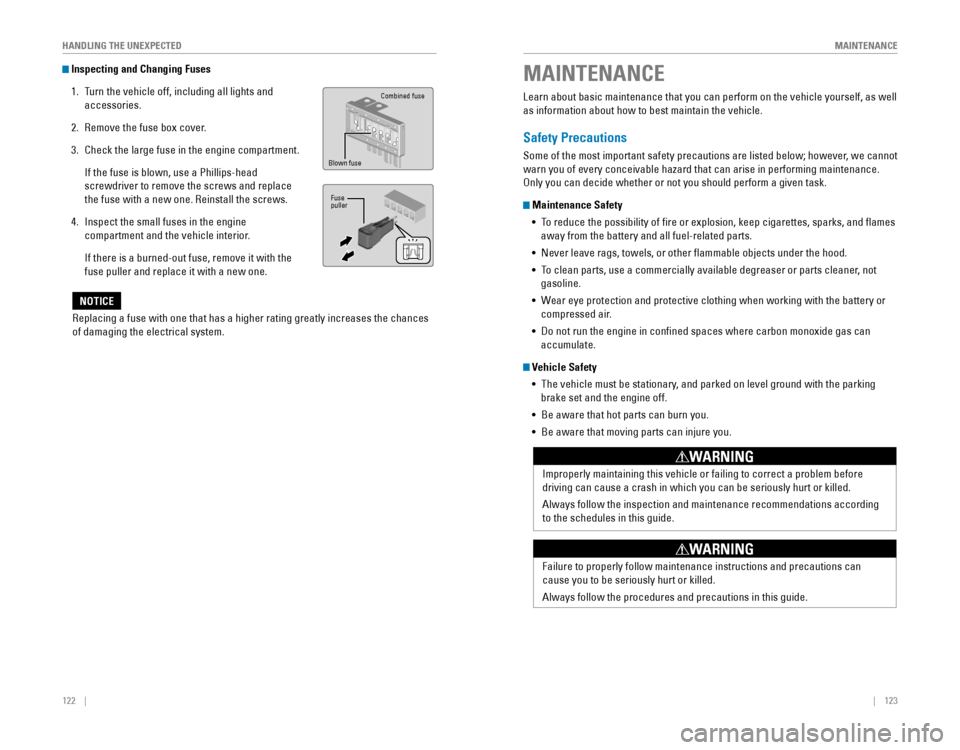
122 || 123
MAINTENANCE
HANDLING THE UNEXPECTED
Inspecting and Changing Fuses
1. Turn the vehicle off, including all lights and
accessories.
2. Remove‚ÄÇthe‚ÄÇfuse‚ÄÇbox‚ÄÇcover.
3. Check the large fuse in the engine compartment.
‚ÄÇIf‚ÄÇthe‚ÄÇfuse‚ÄÇis‚ÄÇblown,‚ÄÇuse‚ÄÇa‚ÄÇPhillips-head‚ÄÇ
screwdriver to remove the screws and replace
the fuse with a new one. Reinstall the screws.
4.‚ÄÇInspect‚ÄÇthe‚ÄÇsmall‚ÄÇfuses‚ÄÇin‚ÄÇthe‚ÄÇengine‚ÄÇ
compartment and the vehicle interior.
‚ÄÇIf‚ÄÇthere‚ÄÇis‚ÄÇa‚ÄÇburned-out‚ÄÇfuse,‚ÄÇremove‚ÄÇit‚ÄÇwith‚ÄÇthe‚ÄÇ
fuse puller and replace it with a new one.
Replacing a fuse with one that has a higher rating greatly increases the\
chances
of damaging the electrical system.
NOTICE
Blown fuse
Combined‚ÄÇfuse
Fuse
puller
Learn‚ÄÇabout‚ÄÇbasic‚ÄÇmaintenance‚ÄÇthat‚ÄÇyou‚ÄÇcan‚ÄÇperform‚ÄÇon‚ÄÇthe‚ÄÇvehicle‚ÄÇyourself,‚ÄÇas‚ÄÇwell‚ÄÇ
as‚ÄÇinformation‚ÄÇabout‚ÄÇhow‚ÄÇto‚ÄÇbest‚ÄÇmaintain‚ÄÇthe‚ÄÇvehicle.
Safety Precautions
Some‚ÄÇof‚ÄÇthe‚ÄÇmost‚ÄÇimportant‚ÄÇsafety‚ÄÇprecautions‚ÄÇare‚ÄÇlisted‚ÄÇbelow;‚ÄÇhowever,‚ÄÇwe‚ÄÇcannot‚ÄÇ
warn‚ÄÇyou‚ÄÇof‚ÄÇevery‚ÄÇconceivable‚ÄÇhazard‚ÄÇthat‚ÄÇcan‚ÄÇarise‚ÄÇin‚ÄÇperforming‚ÄÇmaintenance.‚ÄÇ
Only you can decide whether or not you should perform a given task.
Maintenance Safety • 
To‚ÄÇreduce‚ÄÇthe‚ÄÇpossibility‚ÄÇof‚ÄÇfire‚ÄÇor‚ÄÇexplosion,‚ÄÇkeep‚ÄÇcigarettes,‚ÄÇsparks,‚ÄÇand‚ÄÇflames‚ÄÇ
away‚ÄÇfrom‚ÄÇthe‚ÄÇbattery‚ÄÇand‚ÄÇall‚ÄÇfuel-related‚ÄÇparts.
• Never leave rags, towels, or other flammable objects under the hood.
• To clean parts, use a commercially available degreaser or parts cleaner, not 
gasoline.
• 
Wear‚ÄÇeye‚ÄÇprotection‚ÄÇand‚ÄÇprotective‚ÄÇclothing‚ÄÇwhen‚ÄÇworking‚ÄÇwith‚ÄÇthe‚ÄÇbattery‚ÄÇor‚ÄÇ
compressed air.
• 
Do‚ÄÇnot‚ÄÇrun‚ÄÇthe‚ÄÇengine‚ÄÇin‚ÄÇconfined‚ÄÇspaces‚ÄÇwhere‚ÄÇcarbon‚ÄÇmonoxide‚ÄÇgas‚ÄÇcan‚ÄÇ
accumulate.
Vehicle Safety • 
The‚ÄÇvehicle‚ÄÇmust‚ÄÇbe‚ÄÇstationary,‚ÄÇand‚ÄÇparked‚ÄÇon‚ÄÇlevel‚ÄÇground‚ÄÇwith‚ÄÇthe‚ÄÇparking‚ÄÇ
brake‚ÄÇset‚ÄÇand‚ÄÇthe‚ÄÇengine‚ÄÇoff.
• Be aware that hot parts can burn you.
•  Be aware that moving parts can injure you.
MAINTENANCE
Improperly‚ÄÇmaintaining‚ÄÇthis‚ÄÇvehicle‚ÄÇor‚ÄÇfailing‚ÄÇto‚ÄÇcorrect‚ÄÇa‚ÄÇproblem‚ÄÇbefore‚ÄÇ
driving‚ÄÇcan‚ÄÇcause‚ÄÇa‚ÄÇcrash‚ÄÇin‚ÄÇwhich‚ÄÇyou‚ÄÇcan‚ÄÇbe‚ÄÇseriously‚ÄÇhurt‚ÄÇor‚ÄÇkilled.‚ÄÇ
Always follow the inspection and maintenance recommendations according
to the schedules in this guide.
WARNING
Failure to properly follow maintenance instructions and precautions can \
cause‚ÄÇyou‚ÄÇto‚ÄÇbe‚ÄÇseriously‚ÄÇhurt‚ÄÇor‚ÄÇkilled.
Always follow the procedures and precautions in this guide.
WARNING
Page 67 of 80
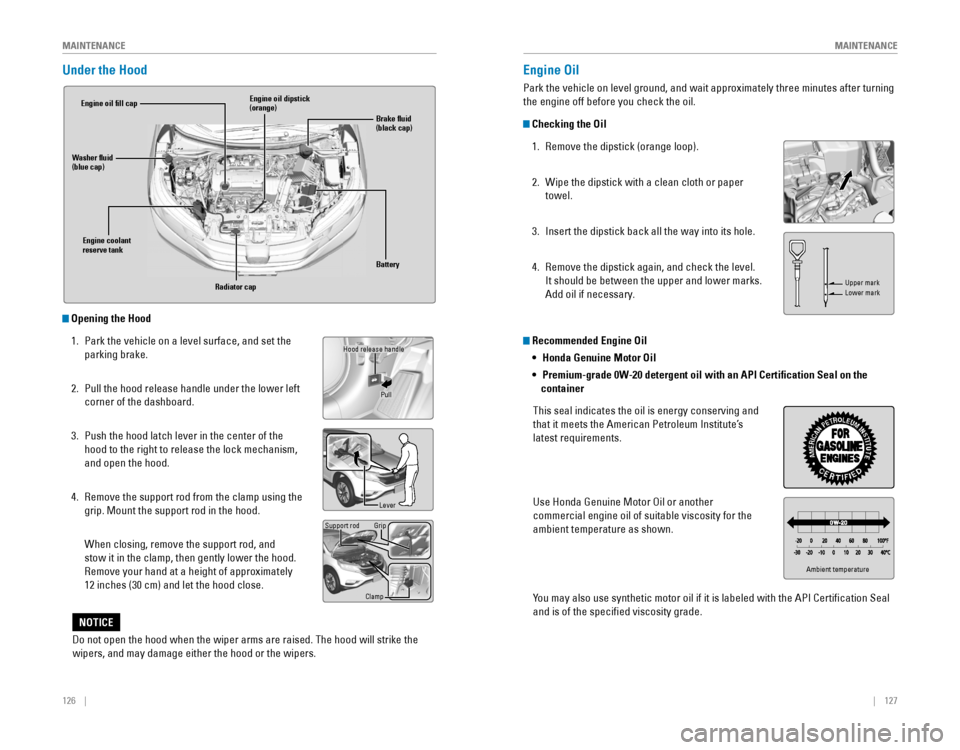
126 ||‚ÄÇ‚ÄÇ‚ÄÇ‚ÄÇ127
MAINTENANCE
MAINTENANCE
Under the Hood
Opening the Hood
1. Park the vehicle on a level surface, and set the
parking‚ÄÇbrake.
2. Pull the hood release handle under the lower left
corner‚ÄÇof‚ÄÇthe‚ÄÇdashboard.
3. Push the hood latch lever in the center of the
hood to the right to release the lock mechanism,
and open the hood.
4.‚ÄÇRemove the support rod from the clamp using the
grip. Mount the support rod in the hood.
When closing, remove the support rod, and
stow it in the clamp, then gently lower the hood.
Remove your hand at a height of approximately
12 inches (30 cm) and let the hood close.
Engine coolant
reserve tank
Washer fluid
(blue cap)
Engine oil fill cap
Engine oil dipstick
(orange)
Brake fluid
(black cap)
Battery
Radiator cap
Hood release handle
Lever
Support rod Grip
ClampPull
Do‚ÄÇnot‚ÄÇopen‚ÄÇthe‚ÄÇhood‚ÄÇwhen‚ÄÇthe‚ÄÇwiper‚ÄÇarms‚ÄÇare‚ÄÇraised.‚ÄÇThe‚ÄÇhood‚ÄÇwill‚ÄÇstrike‚ÄÇthe‚ÄÇ
wipers, and may damage either the hood or the wipers.
NOTICE
Recommended Engine Oil
• 
Honda Genuine Motor Oil
•  Premium-grade 0W-20 detergent oil with an API Certification Seal on the
container
This seal indicates the oil is energy conserving and
that it meets the American Petroleum Institute’s 
latest‚ÄÇrequirements.
Use Honda Genuine Motor Oil or another
commercial‚ÄÇengine‚ÄÇoil‚ÄÇof‚ÄÇsuitable‚ÄÇviscosity‚ÄÇfor‚ÄÇthe‚ÄÇ
ambient‚ÄÇtemperature‚ÄÇas‚ÄÇshown.
You‚ÄÇmay‚ÄÇalso‚ÄÇuse‚ÄÇsynthetic‚ÄÇmotor‚ÄÇoil‚ÄÇif‚ÄÇit‚ÄÇis‚ÄÇlabeled‚ÄÇwith‚ÄÇthe‚ÄÇAPI‚ÄÇCertification‚ÄÇSeal‚ÄÇ
and is of the specified viscosity grade.
Engine Oil
Park the vehicle on level ground, and wait approximately three minutes after turning
the‚ÄÇengine‚ÄÇoff‚ÄÇbefore‚ÄÇyou‚ÄÇcheck‚ÄÇthe‚ÄÇoil.
Checking the Oil
1. Remove the dipstick (orange loop).
2. Wipe the dipstick with a clean cloth or paper
towel.
3. Insert‚ÄÇthe‚ÄÇdipstick‚ÄÇback‚ÄÇall‚ÄÇthe‚ÄÇway‚ÄÇinto‚ÄÇits‚ÄÇhole.
4.‚ÄÇRemove the dipstick again, and check the level.
It‚ÄÇshould‚ÄÇbe‚ÄÇbetween‚ÄÇthe‚ÄÇupper‚ÄÇand‚ÄÇlower‚ÄÇmarks.‚ÄÇ
Add oil if necessary.
Ambient‚ÄÇtemperature
Upper mark
Lower mark
Page 69 of 80
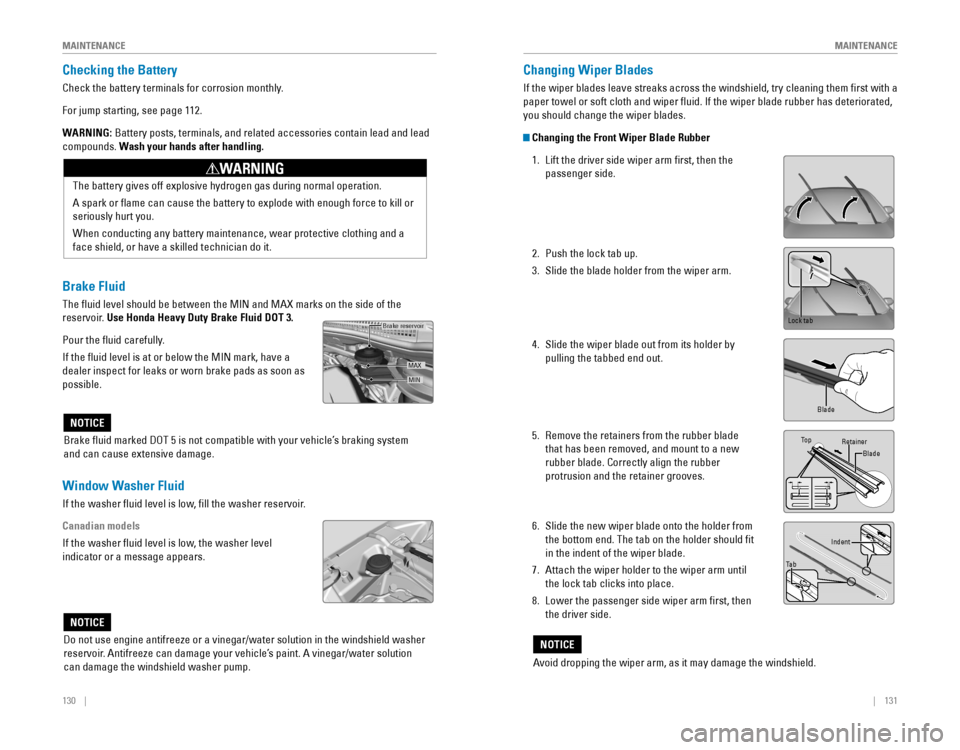
130 || 131
MAINTENANCE
MAINTENANCE
Checking the Battery
Check‚ÄÇthe‚ÄÇbattery‚ÄÇterminals‚ÄÇfor‚ÄÇcorrosion‚ÄÇmonthly.
For jump starting, see page 112.
WARNING: Battery posts, terminals, and related accessories contain lead and lead\
compounds. Wash your hands after handling.
The‚ÄÇbattery‚ÄÇgives‚ÄÇoff‚ÄÇexplosive‚ÄÇhydrogen‚ÄÇgas‚ÄÇduring‚ÄÇnormal‚ÄÇoperation.
A‚ÄÇspark‚ÄÇor‚ÄÇflame‚ÄÇcan‚ÄÇcause‚ÄÇthe‚ÄÇbattery‚ÄÇto‚ÄÇexplode‚ÄÇwith‚ÄÇenough‚ÄÇforce‚ÄÇto‚ÄÇkill‚ÄÇor‚ÄÇ
seriously hurt you.
When‚ÄÇconducting‚ÄÇany‚ÄÇbattery‚ÄÇmaintenance,‚ÄÇwear‚ÄÇprotective‚ÄÇclothing‚ÄÇand‚ÄÇa‚ÄÇ
face shield, or have a skilled technician do it.
WARNING
Do‚ÄÇnot‚ÄÇuse‚ÄÇengine‚ÄÇantifreeze‚ÄÇor‚ÄÇa‚ÄÇvinegar/water‚ÄÇsolution‚ÄÇin‚ÄÇthe‚ÄÇwindshield‚ÄÇwasher‚ÄÇ
reservoir. Antifreeze can damage your vehicle’s paint. A vinegar/water solution 
can damage the windshield washer pump.
NOTICE
Window Washer Fluid
If‚ÄÇthe‚ÄÇwasher‚ÄÇfluid‚ÄÇlevel‚ÄÇis‚ÄÇlow,‚ÄÇfill‚ÄÇthe‚ÄÇwasher‚ÄÇreservoir.‚ÄÇ
Canadian models
If‚ÄÇthe‚ÄÇwasher‚ÄÇfluid‚ÄÇlevel‚ÄÇis‚ÄÇlow,‚ÄÇthe‚ÄÇwasher‚ÄÇlevel‚ÄÇ
indicator or a message appears.
Changing Wiper Blades
If‚ÄÇthe‚ÄÇwiper‚ÄÇblades‚ÄÇleave‚ÄÇstreaks‚ÄÇacross‚ÄÇthe‚ÄÇwindshield,‚ÄÇtry‚ÄÇcleaning‚ÄÇthem‚ÄÇfirst‚ÄÇwith‚ÄÇa‚ÄÇ
paper‚ÄÇtowel‚ÄÇor‚ÄÇsoft‚ÄÇcloth‚ÄÇand‚ÄÇwiper‚ÄÇfluid.‚ÄÇIf‚ÄÇthe‚ÄÇwiper‚ÄÇblade‚ÄÇrubber‚ÄÇhas‚ÄÇdeteriorated,‚ÄÇ
you‚ÄÇshould‚ÄÇchange‚ÄÇthe‚ÄÇwiper‚ÄÇblades.
Changing the Front Wiper Blade Rubber
1. Lift the driver side wiper arm first, then the
passenger side.
2. Push‚ÄÇthe‚ÄÇlock‚ÄÇtab‚ÄÇup.‚ÄÇ
3. Slide‚ÄÇthe‚ÄÇblade‚ÄÇholder‚ÄÇfrom‚ÄÇthe‚ÄÇwiper‚ÄÇarm.
4.‚ÄÇSlide‚ÄÇthe‚ÄÇwiper‚ÄÇblade‚ÄÇout‚ÄÇfrom‚ÄÇits‚ÄÇholder‚ÄÇby‚ÄÇ
pulling‚ÄÇthe‚ÄÇtabbed‚ÄÇend‚ÄÇout.
5. Remove‚ÄÇthe‚ÄÇretainers‚ÄÇfrom‚ÄÇthe‚ÄÇrubber‚ÄÇblade‚ÄÇ
that‚ÄÇhas‚ÄÇbeen‚ÄÇremoved,‚ÄÇand‚ÄÇmount‚ÄÇto‚ÄÇa‚ÄÇnew‚ÄÇ
rubber‚ÄÇblade.‚ÄÇCorrectly‚ÄÇalign‚ÄÇthe‚ÄÇrubber‚ÄÇ
protrusion and the retainer grooves.
6. Slide‚ÄÇthe‚ÄÇnew‚ÄÇwiper‚ÄÇblade‚ÄÇonto‚ÄÇthe‚ÄÇholder‚ÄÇfrom‚ÄÇ
the‚ÄÇbottom‚ÄÇend.‚ÄÇThe‚ÄÇtab‚ÄÇon‚ÄÇthe‚ÄÇholder‚ÄÇshould‚ÄÇfit‚ÄÇ
in‚ÄÇthe‚ÄÇindent‚ÄÇof‚ÄÇthe‚ÄÇwiper‚ÄÇblade.
7.‚ÄÇAttach the wiper holder to the wiper arm until
the‚ÄÇlock‚ÄÇtab‚ÄÇclicks‚ÄÇinto‚ÄÇplace.
8. Lower the passenger side wiper arm first, then
the driver side.
Lock‚ÄÇtab
Blade
To p Retainer
Blade
Ta b Indent
Avoid dropping the wiper arm, as it may damage the windshield.
NOTICE
Brake fluid marked DOT 5 is not compatible with your vehicle’s braking system 
and can cause extensive damage.
NOTICE
Brake Fluid
The‚ÄÇfluid‚ÄÇlevel‚ÄÇshould‚ÄÇbe‚ÄÇbetween‚ÄÇthe‚ÄÇMIN‚ÄÇand‚ÄÇMAX‚ÄÇmarks‚ÄÇon‚ÄÇthe‚ÄÇside‚ÄÇof‚ÄÇthe‚ÄÇ
reservoir. Use Honda Heavy Duty Brake Fluid DOT 3.
Pour the fluid carefully.
If‚ÄÇthe‚ÄÇfluid‚ÄÇlevel‚ÄÇis‚ÄÇat‚ÄÇor‚ÄÇbelow‚ÄÇthe‚ÄÇMIN‚ÄÇmark,‚ÄÇhave‚ÄÇa‚ÄÇ
dealer‚ÄÇinspect‚ÄÇfor‚ÄÇleaks‚ÄÇor‚ÄÇworn‚ÄÇbrake‚ÄÇpads‚ÄÇas‚ÄÇsoon‚ÄÇas‚ÄÇ
possible.
Brake reservoir
MIN
MAX
Page 73 of 80
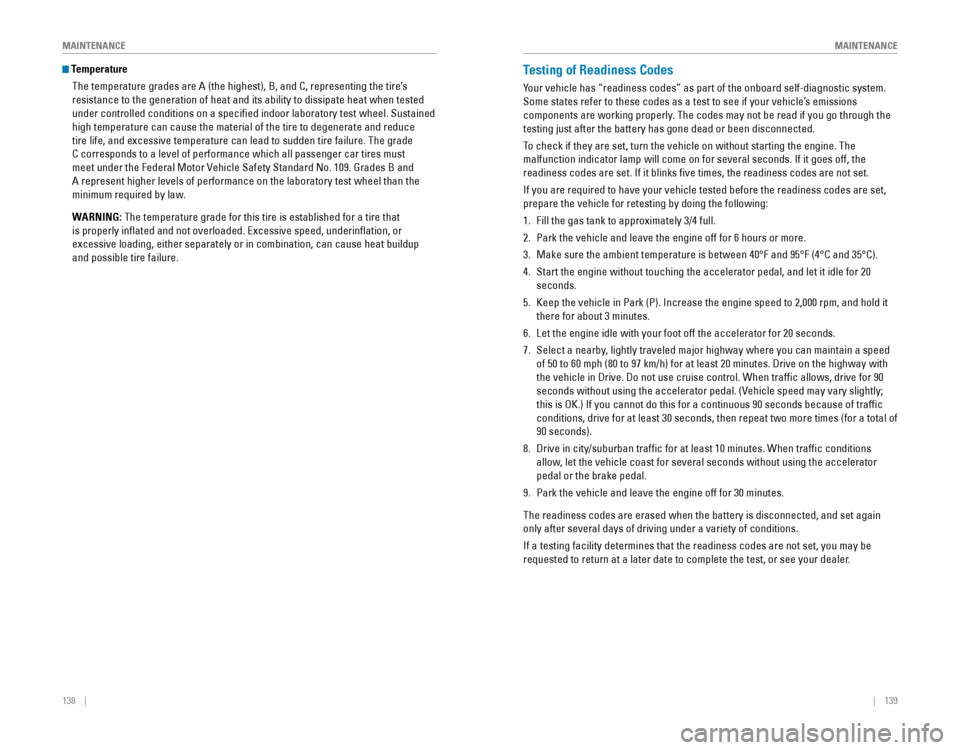
138 || 139
MAINTENANCE
MAINTENANCE
Temperature
The temperature grades are A (the highest), B, and C, representing the\
tire’s
resistance‚ÄÇto‚ÄÇthe‚ÄÇgeneration‚ÄÇof‚ÄÇheat‚ÄÇand‚ÄÇits‚ÄÇability‚ÄÇto‚ÄÇdissipate‚ÄÇheat‚ÄÇwhen‚ÄÇtested‚ÄÇ
under‚ÄÇcontrolled‚ÄÇconditions‚ÄÇon‚ÄÇa‚ÄÇspecified‚ÄÇindoor‚ÄÇlaboratory‚ÄÇtest‚ÄÇwheel.‚ÄÇSustained‚ÄÇ
high temperature can cause the material of the tire to degenerate and re\
duce
tire life, and excessive temperature can lead to sudden tire failure. Th\
e grade
C corresponds to a level of performance which all passenger car tires must
meet under the Federal Motor Vehicle Safety Standard No. 109. Grades B and
A‚ÄÇrepresent‚ÄÇhigher‚ÄÇlevels‚ÄÇof‚ÄÇperformance‚ÄÇon‚ÄÇthe‚ÄÇlaboratory‚ÄÇtest‚ÄÇwheel‚ÄÇthan‚ÄÇthe‚ÄÇ
minimum‚ÄÇrequired‚ÄÇby‚ÄÇlaw.
WARNING:‚ÄÇThe‚ÄÇtemperature‚ÄÇgrade‚ÄÇfor‚ÄÇthis‚ÄÇtire‚ÄÇis‚ÄÇestablished‚ÄÇfor‚ÄÇa‚ÄÇtire‚ÄÇthat‚ÄÇ
is‚ÄÇproperly‚ÄÇinflated‚ÄÇand‚ÄÇnot‚ÄÇoverloaded.‚ÄÇExcessive‚ÄÇspeed,‚ÄÇunderinflation,‚ÄÇor‚ÄÇ
excessive‚ÄÇloading,‚ÄÇeither‚ÄÇseparately‚ÄÇor‚ÄÇin‚ÄÇcombination,‚ÄÇcan‚ÄÇcause‚ÄÇheat‚ÄÇbuildup‚ÄÇ
and‚ÄÇpossible‚ÄÇtire‚ÄÇfailure.
Testing of Readiness Codes
Your vehicle has “readiness codes” as part of the onboard self-diagnostic system. 
Some states refer to these codes as a test to see if your vehicle’s emissions
components‚ÄÇare‚ÄÇworking‚ÄÇproperly.‚ÄÇThe‚ÄÇcodes‚ÄÇmay‚ÄÇnot‚ÄÇbe‚ÄÇread‚ÄÇif‚ÄÇyou‚ÄÇgo‚ÄÇthrough‚ÄÇthe‚ÄÇ
testing‚ÄÇjust‚ÄÇafter‚ÄÇthe‚ÄÇbattery‚ÄÇhas‚ÄÇgone‚ÄÇdead‚ÄÇor‚ÄÇbeen‚ÄÇdisconnected.
To check if they are set, turn the vehicle on without starting the engine\
. The
malfunction‚ÄÇindicator‚ÄÇlamp‚ÄÇwill‚ÄÇcome‚ÄÇon‚ÄÇfor‚ÄÇseveral‚ÄÇseconds.‚ÄÇIf‚ÄÇit‚ÄÇgoes‚ÄÇoff,‚ÄÇthe‚ÄÇ
readiness‚ÄÇcodes‚ÄÇare‚ÄÇset.‚ÄÇIf‚ÄÇit‚ÄÇblinks‚ÄÇfive‚ÄÇtimes,‚ÄÇthe‚ÄÇreadiness‚ÄÇcodes‚ÄÇare‚ÄÇnot‚ÄÇset.
If‚ÄÇyou‚ÄÇare‚ÄÇrequired‚ÄÇto‚ÄÇhave‚ÄÇyour‚ÄÇvehicle‚ÄÇtested‚ÄÇbefore‚ÄÇthe‚ÄÇreadiness‚ÄÇcodes‚ÄÇare‚ÄÇset,‚ÄÇ
prepare‚ÄÇthe‚ÄÇvehicle‚ÄÇfor‚ÄÇretesting‚ÄÇby‚ÄÇdoing‚ÄÇthe‚ÄÇfollowing:
1. Fill‚ÄÇthe‚ÄÇgas‚ÄÇtank‚ÄÇto‚ÄÇapproximately‚ÄÇ3/4‚ÄÇfull.
2. Park the vehicle and leave the engine off for 6 hours or more.
3. Make sure the ambient temperature is between 40°F and 95°F (4°C and 35°C).
4.‚ÄÇStart the engine without touching the accelerator pedal, and let it idle\
for 20
seconds.
5. Keep‚ÄÇthe‚ÄÇvehicle‚ÄÇin‚ÄÇPark‚ÄÇ(P).‚ÄÇIncrease‚ÄÇthe‚ÄÇengine‚ÄÇspeed‚ÄÇto‚ÄÇ2,000‚ÄÇrpm,‚ÄÇand‚ÄÇhold‚ÄÇit‚ÄÇ
there‚ÄÇfor‚ÄÇabout‚ÄÇ3‚ÄÇminutes.
6. Let the engine idle with your foot off the accelerator for 20 seconds.
7.‚ÄÇSelect‚ÄÇa‚ÄÇnearby,‚ÄÇlightly‚ÄÇtraveled‚ÄÇmajor‚ÄÇhighway‚ÄÇwhere‚ÄÇyou‚ÄÇcan‚ÄÇmaintain‚ÄÇa‚ÄÇspeed‚ÄÇ
of‚ÄÇ50‚ÄÇto‚ÄÇ60‚ÄÇmph‚ÄÇ(80‚ÄÇto‚ÄÇ97‚ÄÇkm/h)‚ÄÇfor‚ÄÇat‚ÄÇleast‚ÄÇ20‚ÄÇminutes.‚ÄÇDrive‚ÄÇon‚ÄÇthe‚ÄÇhighway‚ÄÇwith‚ÄÇ
the‚ÄÇvehicle‚ÄÇin‚ÄÇDrive.‚ÄÇDo‚ÄÇnot‚ÄÇuse‚ÄÇcruise‚ÄÇcontrol.‚ÄÇWhen‚ÄÇtraffic‚ÄÇallows,‚ÄÇdrive‚ÄÇfor‚ÄÇ90‚ÄÇ
seconds without using the accelerator pedal. (Vehicle speed may vary slightly;
this‚ÄÇis‚ÄÇOK.)‚ÄÇIf‚ÄÇyou‚ÄÇcannot‚ÄÇdo‚ÄÇthis‚ÄÇfor‚ÄÇa‚ÄÇcontinuous‚ÄÇ90‚ÄÇseconds‚ÄÇbecause‚ÄÇof‚ÄÇtraffic‚ÄÇ
conditions, drive for at least 30 seconds, then repeat two more times (\
for a total of
90 seconds).
8. Drive‚ÄÇin‚ÄÇcity/suburban‚ÄÇtraffic‚ÄÇfor‚ÄÇat‚ÄÇleast‚ÄÇ10‚ÄÇminutes.‚ÄÇWhen‚ÄÇtraffic‚ÄÇconditions‚ÄÇ
allow, let the vehicle coast for several seconds without using the accelerator
pedal‚ÄÇor‚ÄÇthe‚ÄÇbrake‚ÄÇpedal.
9. Park the vehicle and leave the engine off for 30 minutes.
The‚ÄÇreadiness‚ÄÇcodes‚ÄÇare‚ÄÇerased‚ÄÇwhen‚ÄÇthe‚ÄÇbattery‚ÄÇis‚ÄÇdisconnected,‚ÄÇand‚ÄÇset‚ÄÇagain‚ÄÇ
only after several days of driving under a variety of conditions.
If‚ÄÇa‚ÄÇtesting‚ÄÇfacility‚ÄÇdetermines‚ÄÇthat‚ÄÇthe‚ÄÇreadiness‚ÄÇcodes‚ÄÇare‚ÄÇnot‚ÄÇset,‚ÄÇyou‚ÄÇmay‚ÄÇbe‚ÄÇ
requested‚ÄÇto‚ÄÇreturn‚ÄÇat‚ÄÇa‚ÄÇlater‚ÄÇdate‚ÄÇto‚ÄÇcomplete‚ÄÇthe‚ÄÇtest,‚ÄÇor‚ÄÇsee‚ÄÇyour‚ÄÇdealer.
Page 74 of 80
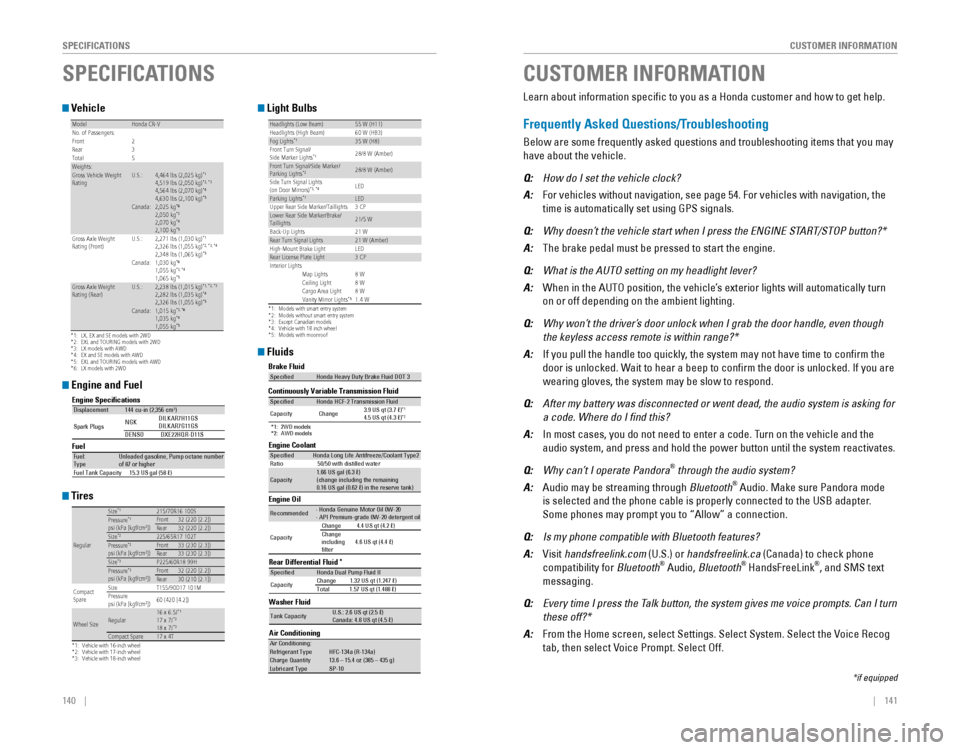
140‚ÄÇ‚ÄÇ‚ÄÇ‚ÄÇ||‚ÄÇ‚ÄÇ‚ÄÇ‚ÄÇ141
CUSTOMER INFORMATION
SPECIFICATIONS
Vehicle
*1:LX, EX and SE models with 2WD*2:EXL and TOURING models with 2WD*3:LX models with AWD*4:EX and SE models with AWD*5:EXL and TOURING models with AWD*6: LX models with 2WD
ModelHonda CR- VNo. of Passengers:
Front 2
Rear 3
Tota l5
Weights:Gross Vehicle Weight
Rating U.S.:4,464 lbs (2,025 kg )*14,519 lbs (2,050 kg)*2, *34,564 lbs (2,070 kg )*44,630 lbs (2,100 kg)*5Canada:2,025 kg*62,050 kg*32,070 kg*42,100 kg*5Gross Axle Weight
Rating (Front)U.S.:2,271 lbs (1,030 kg )*12,326 lbs (1,055 kg)*2, *3 , *42,348 lbs (1,065 kg )*5Canada:1,030 kg*61,055 kg*3, *41,065 kg*5Gross Axle Weight
Rating (Rear)U.S.:2,238 lbs (1,015 kg )*1, *2 , *32,282 lbs (1,035 kg )*42,326 lbs (1,055 kg)*5Canada:1,015 kg*3, *61,035 kg*41,055 kg*5
Engine and Fuel
Engine Speci�cation s
FuelDisplacemen t144 cu-in (2,356 cm3)
Spark Plugs NG
K DILKAR7H11GS
DILKAR7G11GS
DENSO DXE22HQR-D11 S
Fuel:
TypeUnleaded gasoline, Pump octane number of 87 or higher
Fuel Tank Capacity 15.3 US gal (58 �)
Tires
*1:Vehicle with 16-inch wheel*2:Vehicle with 17-inch wheel*3: Vehicle with 18-inch wheel
Regular
Size*1215/70R16 100 SPressure*1psi (k Pa [kgf/cm2])Front32 (220 [2.2])Rear32 (220 [2.2])Size*2225/65R17 102 TPressure*2psi (k Pa [kgf/cm2])Front33 (230 [2.3])Rear33 (230 [2.3])Size*3P225/60R18 99HPressure*3psi (k Pa [kgf/cm2])Front32 (220 [2.2])Rear30 (210 [2.1])
Compact
Spar e Size
T155/90D17 101M
Pr essure
psi (k Pa [kgf/cm
2])60 (420 [4.2])
Wheel SizeRegular16 x 6.5J*117 x 7J*218 x 7J*3Compact Spar
e17 x 4T
Light Bulbs
*1:Models with smart entry system*2:Models without smart entry system*3:Except Canadian models *4:Vehicle with 18 inch whee l*5: Models with moonroof
Headlights (Low Beam)55 W (H11 )Headlights (High Beam) 60 W (HB3)Fog Lights*135 W (H8)
Front Turn Signal/
Side Marker Light s
*128/8 W (Amber)
Front Turn Signal/Side Marker /
Parking Light s*228/8 W (Amber)
Side Turn Signal Lights
(on Door Mirrors )
*3, *4LED
Parking Light s*1LED
Upper Rear Side Marker/Taillight s3 CP
Lower Rear Side Marker/Brake/
Taillight s21/5 W
Back-Up Lights 21 W
Rear Turn Signal Light s21 W (Amber)
High- Mount Brak e LightL ED
Rear License Plate Light3 CP
In teri or Lights
Map Lights 8 W
Ceiling Light 8 W
Cargo Area Light 8 W
Vanity Mirror Lights
*51.4 W
Fluids
Washer Fluid
Tank Capacit yU.S.: 2.6 US qt (2.5 �)
Canada: 4.8 US qt (4.5 �)
Brake Fluid
Continuously Variable Transmission Fluid
*1: 2WD models
*2: AWD models
Rear Differential Fluid*
Speci�e dHonda Heavy Duty Brake Fluid DOT 3
Speci�edHonda HCF-2 Transmission Flui d
Capacity Change 3.9 US qt (3.7 �)*14.5 US qt (4.3 �)*2
Speci�e
dHonda Dual Pump Fluid II
Capacity Change
1.32 US qt (1.247 �)
Tota l1 .57 US qt (1.488 �)
Engine Oil
Engine Coolant
Recommende d· Honda Genuine Motor Oil 0W-2 0
· API Premium-grade 0W-20 detergent oi l
Capacity Change
4.4 US qt (4.2 �)
Change
including
�lter 4.6 US qt (4.4 �)
Speci�e
dHonda Long Life Anti freeze/Coolant Type 2
Ratio 50/50 with distilled wate r
Capacity1.66 US gal (6.3 �)
(change including the remaining
0.16 US gal (0.62 �) in the reserve tank )
Air ConditioningAir Conditioning:Refrigerant Type HFC-134a (R-134a)Charge Quantity13.6 – 15.4 oz (385 – 435 g)Lubricant TypeSP-10
SPECIFICATIONS
Learn‚ÄÇabout‚ÄÇinformation‚ÄÇspecific‚ÄÇto‚ÄÇyou‚ÄÇas‚ÄÇa‚ÄÇHonda‚ÄÇcustomer‚ÄÇand‚ÄÇhow‚ÄÇto‚ÄÇget‚ÄÇhelp.
Frequently Asked Questions/Troubleshooting
Below‚ÄÇare‚ÄÇsome‚ÄÇfrequently‚ÄÇasked‚ÄÇquestions‚ÄÇand‚ÄÇtroubleshooting‚ÄÇitems‚ÄÇthat‚ÄÇyou‚ÄÇmay‚ÄÇ
have‚ÄÇabout‚ÄÇthe‚ÄÇvehicle.
Q: How‚ÄÇdo‚ÄÇI‚ÄÇset‚ÄÇthe‚ÄÇvehicle‚ÄÇclock?
A:‚ÄÇFor‚ÄÇvehicles‚ÄÇwithout‚ÄÇnavigation,‚ÄÇsee‚ÄÇpage‚ÄÇ54.‚ÄÇFor‚ÄÇvehicles‚ÄÇwith‚ÄÇnavigation,‚ÄÇthe
time is automatically set using GPS signals.
Q: Why doesn’t the vehicle start when I press the ENGINE START/STOP button?*
A:‚ÄÇThe‚ÄÇbrake‚ÄÇpedal‚ÄÇmust‚ÄÇbe‚ÄÇpressed‚ÄÇto‚ÄÇstart‚ÄÇthe‚ÄÇengine.
Q: What‚ÄÇis‚ÄÇthe‚ÄÇAUTO‚ÄÇsetting‚ÄÇon‚ÄÇmy‚ÄÇheadlight‚ÄÇlever?
A: When in the AUTO position, the vehicle’s exterior lights will automatically turn
‚ÄÇon‚ÄÇor‚ÄÇoff‚ÄÇdepending‚ÄÇon‚ÄÇthe‚ÄÇambient‚ÄÇlighting.
Q: Why won’t the driver’s door unlock when I grab the door handle, even though 
‚ÄÇthe‚ÄÇkeyless‚ÄÇaccess‚ÄÇremote‚ÄÇis‚ÄÇwithin‚ÄÇrange?*
A:‚ÄÇIf‚ÄÇyou‚ÄÇpull‚ÄÇthe‚ÄÇhandle‚ÄÇtoo‚ÄÇquickly,‚ÄÇthe‚ÄÇsystem‚ÄÇmay‚ÄÇnot‚ÄÇhave‚ÄÇtime‚ÄÇto‚ÄÇconfirm‚ÄÇthe
‚ÄÇdoor‚ÄÇis‚ÄÇunlocked.‚ÄÇWait‚ÄÇto‚ÄÇhear‚ÄÇa‚ÄÇbeep‚ÄÇto‚ÄÇconfirm‚ÄÇthe‚ÄÇdoor‚ÄÇis‚ÄÇunlocked.‚ÄÇIf‚ÄÇyou‚ÄÇare
‚ÄÇwearing‚ÄÇgloves,‚ÄÇthe‚ÄÇsystem‚ÄÇmay‚ÄÇbe‚ÄÇslow‚ÄÇto‚ÄÇrespond.
Q: After‚ÄÇmy‚ÄÇbattery‚ÄÇwas‚ÄÇdisconnected‚ÄÇor‚ÄÇwent‚ÄÇdead,‚ÄÇthe‚ÄÇaudio‚ÄÇsystem‚ÄÇis‚ÄÇasking‚ÄÇfor‚ÄÇ
‚ÄÇa‚ÄÇcode.‚ÄÇWhere‚ÄÇdo‚ÄÇI‚ÄÇfind‚ÄÇthis?
A:‚ÄÇIn‚ÄÇmost‚ÄÇcases,‚ÄÇyou‚ÄÇdo‚ÄÇnot‚ÄÇneed‚ÄÇto‚ÄÇenter‚ÄÇa‚ÄÇcode.‚ÄÇTurn‚ÄÇon‚ÄÇthe‚ÄÇvehicle‚ÄÇand‚ÄÇthe
‚ÄÇaudio‚ÄÇsystem,‚ÄÇand‚ÄÇpress‚ÄÇand‚ÄÇhold‚ÄÇthe‚ÄÇpower‚ÄÇbutton‚ÄÇuntil‚ÄÇthe‚ÄÇsystem‚ÄÇreactivates.
Q: Why can’t I operate Pandora® through the audio system?
A: Audio may be streaming through Bluetooth® Audio. Make sure Pandora mode
‚ÄÇis‚ÄÇselected‚ÄÇand‚ÄÇthe‚ÄÇphone‚ÄÇcable‚ÄÇis‚ÄÇproperly‚ÄÇconnected‚ÄÇto‚ÄÇthe‚ÄÇUSB‚ÄÇadapter.
Some phones may prompt you to “Allow” a connection.
Q: Is‚ÄÇmy‚ÄÇphone‚ÄÇcompatible‚ÄÇwith‚ÄÇBluetooth‚ÄÇfeatures?
A: Visit handsfreelink.com‚ÄÇ(U.S.) or handsfreelink.ca‚ÄÇ(Canada) to check phone
 compatibility for Bluetooth® Audio, Bluetooth® HandsFreeLink®, and SMS text
messaging.
Q: Every‚ÄÇtime‚ÄÇI‚ÄÇpress‚ÄÇthe‚ÄÇTalk‚ÄÇbutton,‚ÄÇthe‚ÄÇsystem‚ÄÇgives‚ÄÇme‚ÄÇvoice‚ÄÇprompts.‚ÄÇCan‚ÄÇI‚ÄÇturn‚ÄÇ
‚ÄÇthese‚ÄÇoff?*
A: From the Home screen, select Settings. Select System. Select the Voice Recog
‚ÄÇtab,‚ÄÇthen‚ÄÇselect‚ÄÇVoice‚ÄÇPrompt.‚ÄÇSelect‚ÄÇOff.
CUSTOMER INFORMATION
*if‚ÄÇequipped